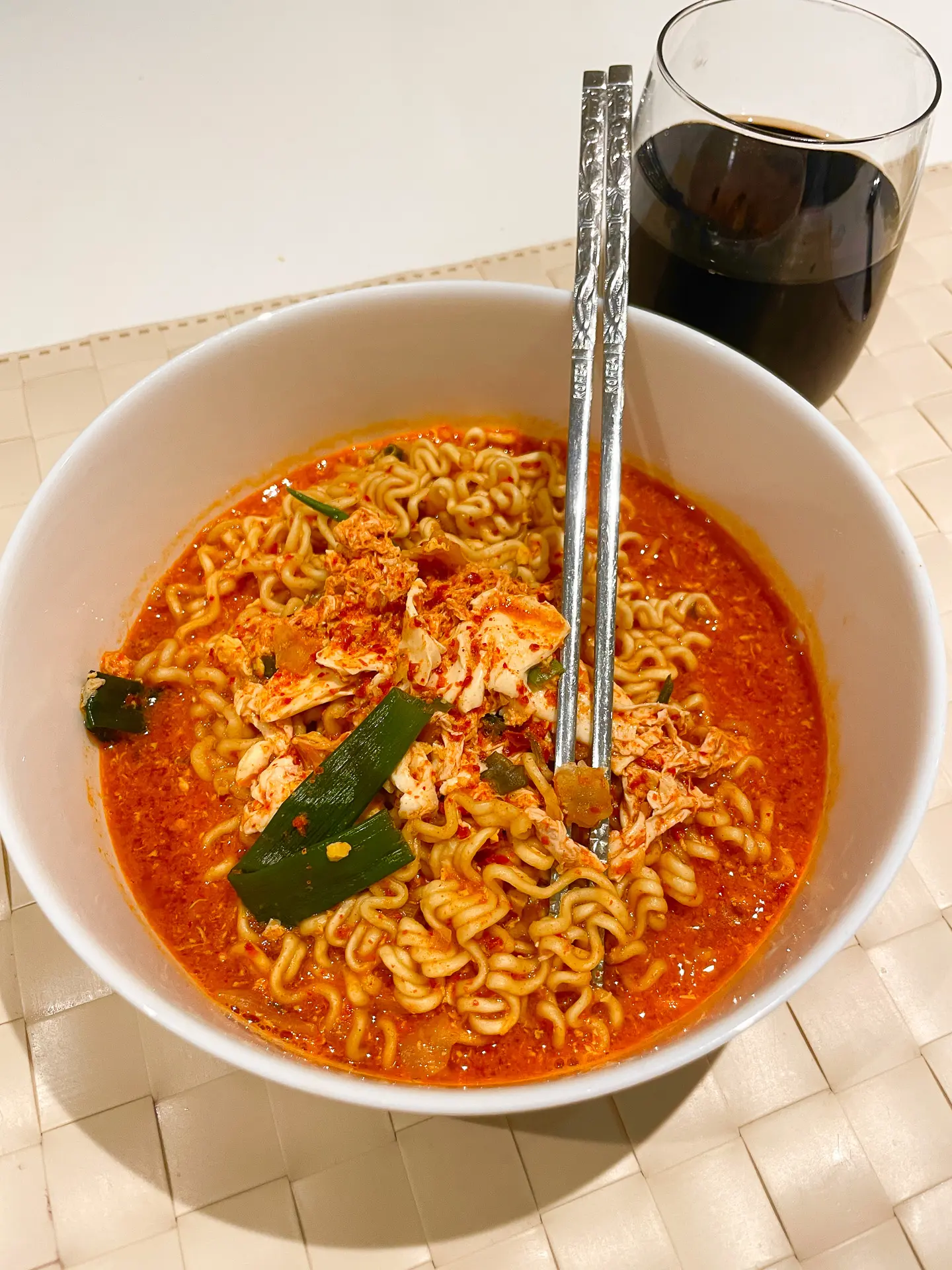Let’s explore the 10 best Korean ramen brands! With so many options out there, it can be hard to choose the right one. Today, I’m going to introduce you to the top 10 most popular Korean instant ramen(ramyun) in 2024, based on sales rankings in Korea.
Table of Contents
Korean Ramen (Ramyun) 라면
What makes Korean ramen unique?
- Rich Broth
Korean ramen is known for its deep, flavorful broth. Many varieties have a spicy kick, and beef-flavored broths are common.
- Chewy Noodles
Most Korean ramen noodles(instant noodles) are fried, which gives them a satisfying, chewy texture. While healthier, non-fried options are becoming more popular, the majority of noodles are still fried. This springy, chewy bite is a hallmark of Korean ramen.
- Variety of Ramen Types
1. Broth Ramen (Gukmul Ramen)
Characterized by its red, spicy broth, this type of ramen is popular in Korea as a hangover cure. Examples include Shin Ramyun, Jin Ramen, and Ansungtangmyun.
2. Fried Noodles (Bokkeum Myeon):
These noodles are cooked and then mixed with liquid or powdered sauce. The most popular varieties are Chapaghetti (Korean black bean noodles) and Buldak Bokkeum Myeon (spicy chicken fried noodles).
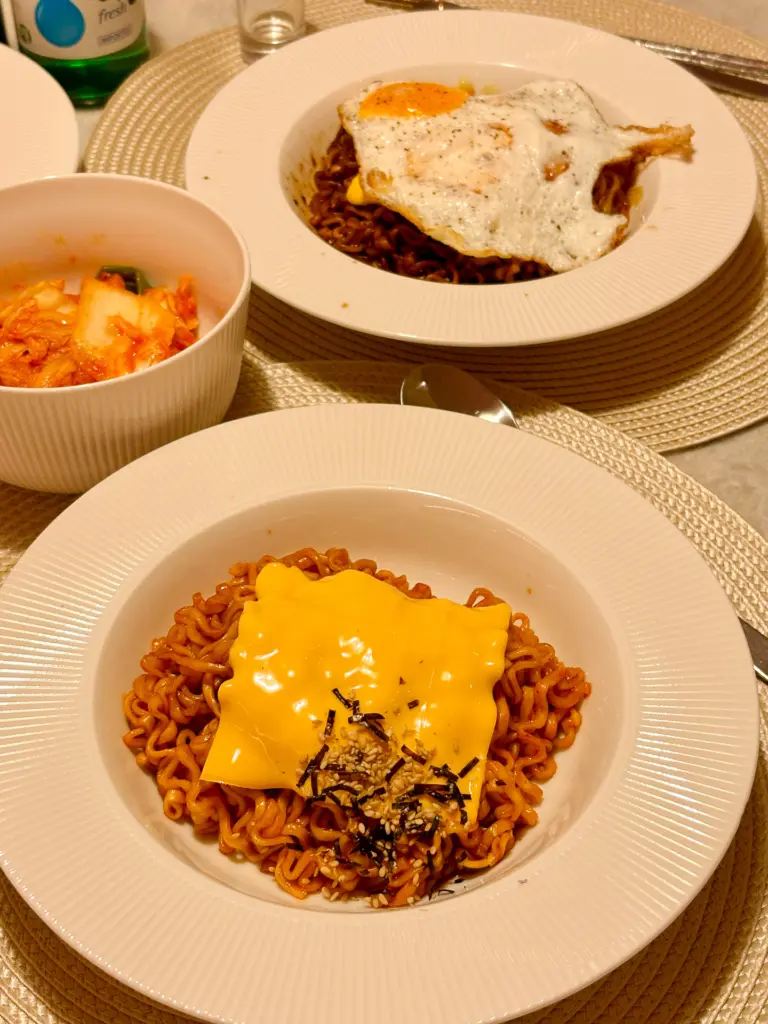
3. Bibim Noodles (Bibim Myeon):
These noodles are mixed with a spicy, tangy sauce and served cold. Paldo Bibim Myeon is the most popular, especially as a refreshing meal in the summer.
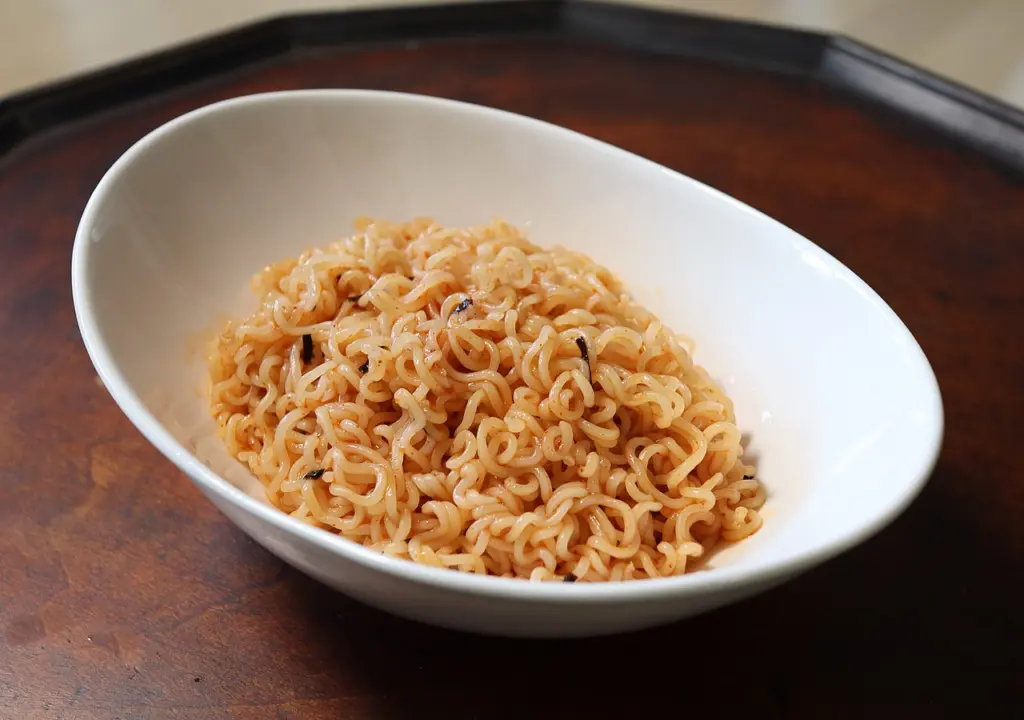
- Unique Toppings
- Chapaghetti comes with a bag of olive oil to add at the end.
- Buldak Bokkeum Myeon contains seaweed flakes for added flavor.
- Chamke Ramen has egg blocks in the soup mix.
What is Korean ramen different from japanese?
Taste and Style
Korean Ramen: It’s an instant noodle dish typically eaten at home. The broth is usually made with beef-flavored powdered soup, which provides a spicy and umami-rich flavor. It often contains vegetable flakes that add depth to the broth.
Japanese Ramen: It’s commonly served in restaurants, where the broth is made from scratch. The broth base varies from tonkotsu (pork bone) to miso and shoyu, with a rich, non-spicy flavor achieved by simmering the broth for a long time. Each region of Japan has its own style of ramen, contributing to the diversity of flavors.
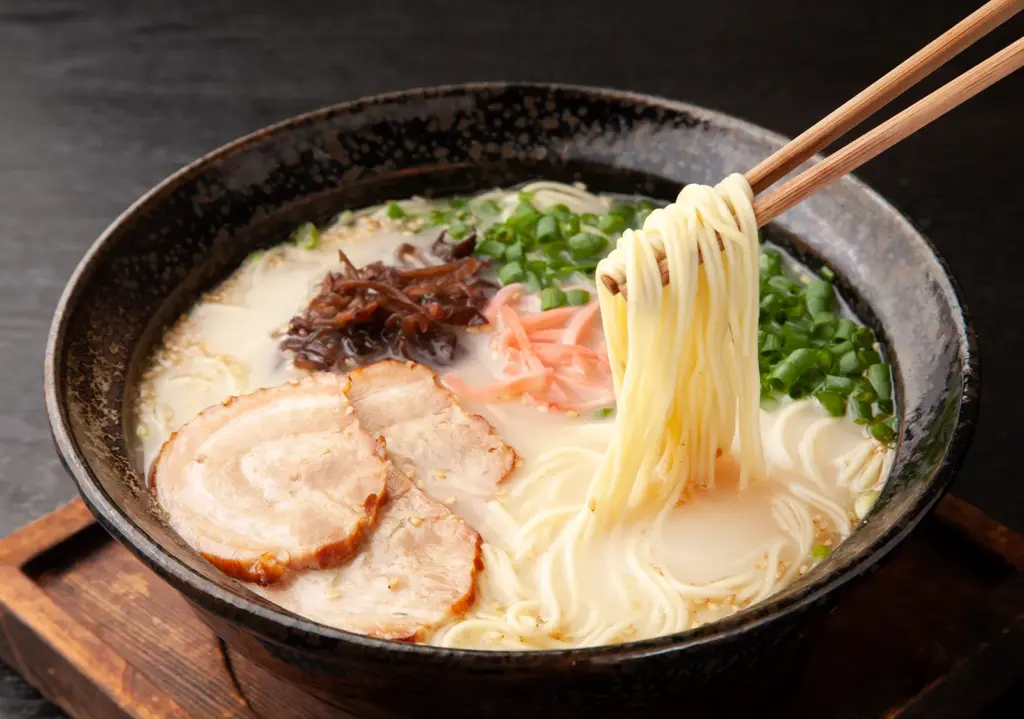
Noodles
Korean Ramen: The noodles are curly and fried in oil, giving them a chewy texture. Many non-fried (air-dried) options have recently become available.
Japanese Ramen: Fresh, unfried noodles are used, ranging from thick to thin. The noodles are generally softer in texture than Korean ramen.
Cooking Method
Korean Ramen: Noodles and soup powder are cooked together in water, and toppings such as egg and green onion can be added as desired.
Japanese Ramen: The broth and noodles are cooked separately. The cooked noodles are served with the broth poured over them, and toppings such as soft-boiled egg and chashu (braised pork) are added on top.
How to Cook Ramen Like a Korean?
Have you ever wondered, “What’s the right way to cook ramen?” or “How can I make instant ramen taste better?” Here’s an easy guide! Just follow these steps and you’ll be enjoying delicious Korean ramen in no time.
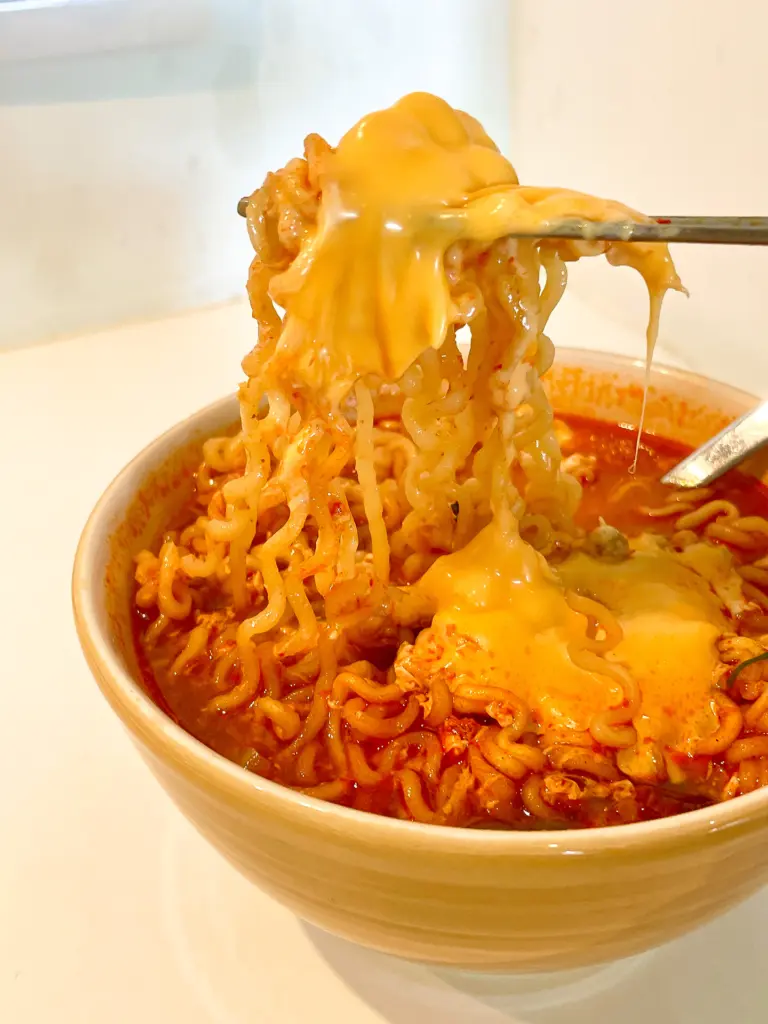
- Boil Water: Pour the exact amount of water indicated on the ramen packet into a pot and bring to a boil.
- Add Seasoning Early: Before the water comes to a boil, add the soup powder and vegetable flakes. This step will enhance the flavor of the broth.
- Cook the Noodles: Once the water is boiling, add the noodles.
- Pro Tip: Do NOT Cover the Pot!
- Keeping the lid off helps achieve the perfect chewy texture.
- Aerate the Noodles:
- Use chopsticks to gently lift the noodles up and down during cooking. This allows the noodles to interact with the air, giving them a firmer, springier texture.
- Add the Egg:
- When the noodles are about 90% cooked (about 2 minutes later), break an egg into the pot.
Follow these steps, and you’ll enjoy perfectly chewy and delicious Korean ramen every time!
Creative Recipes Using Korean Ramen
BTS Jungkook’s “Rajuk”
Rajuk is a combination of ramen and juk (Korean rice porridge). Crush ramen noodles into small pieces and cook in ramen broth. Add the buldak sauce, seaweed flakes and rice and simmer until thickened. Finish with a drizzle of perilla oil and a dash of black pepper for a nutty and spicy flavor.

BTS Jungkook’s “Bulguri”
This recipe combines Buldak and Neoguri ramen, inspired by Jungkook. Boil 600-680 ml of water in a frying pan, cook both ramens together, and add a splash of perilla oil at the end. It’s a popular ramen combo in Korea, offering deep umami and spice.
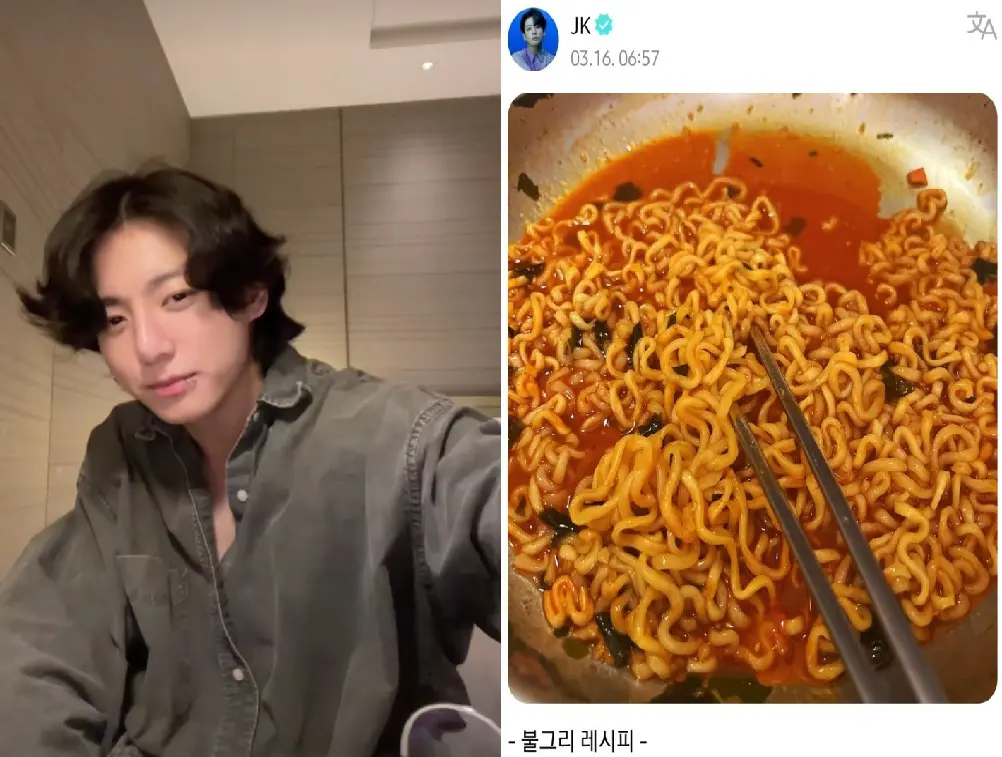
Buldak Omelette
This is Buldak omelette recipe. trendy Malaysian dish uses buldak ramen to create a spicy omelette. The eggs are stuffed with cheese, sausage, and Buldak ramen for a perfect balance of heat and creamy, savory flavors.
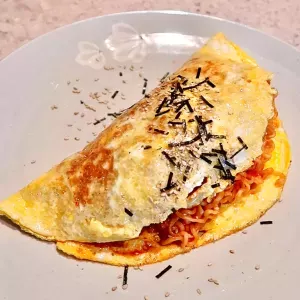
Korean Ramen Hack
Korean Ramen Hack The easiest way to elevate your ramen is to add toppings. Here are some of the most popular ramen toppings in Korea.
- Cheese: Use a slice of cheese for the best results. It melts perfectly into the broth, creating a rich and creamy cheese ramen.
- Egg: The most common topping! It adds protein and, when mixed with the broth, creates a deliciously comforting flavor.
- Red Pepper Powder & Cheongyang Chili: For those who love spicy food, adding Korean red pepper powder (gochugaru) and Cheongyang chili peppers gives the broth an extra kick. This is especially recommended for a hangover cure!
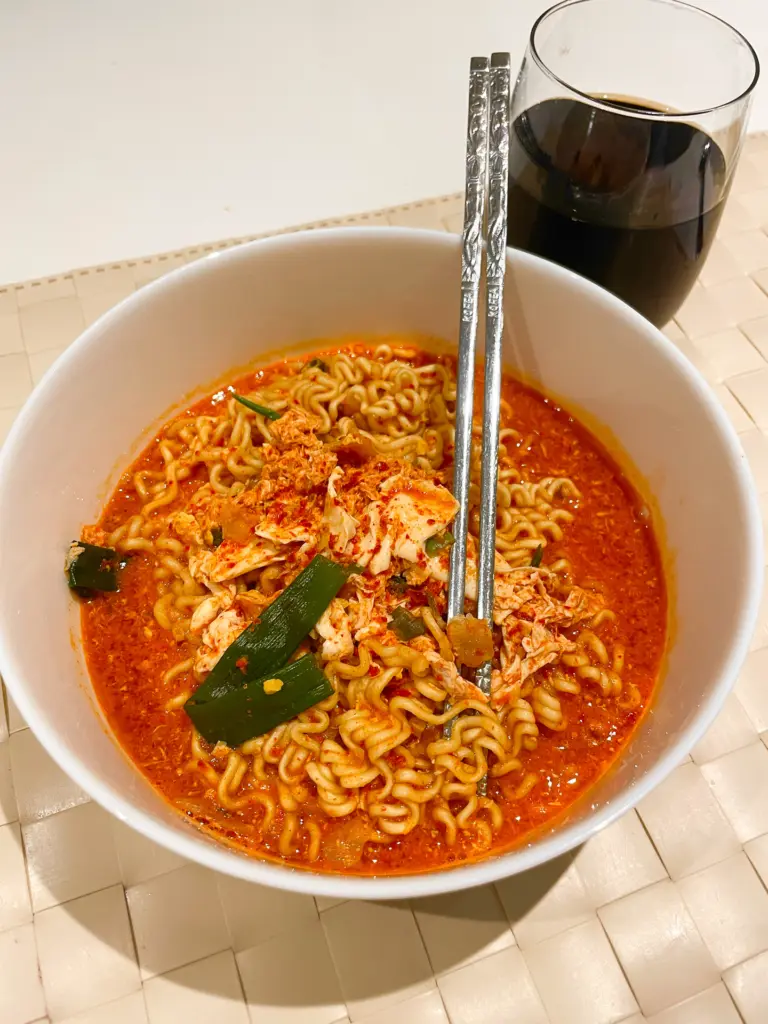
- Green Onions: Finely chop green onions and add them to the ramen for a deeper, more aromatic broth.
When Do Koreans Eat Ramen?
Koreans eat ramen anytime! It’s our ultimate comfort food.
- Weekend Breakfast: Many Koreans also enjoy ramen in the morning on weekends.
- Quick Lunch: It’s a go-to meal at convenience stores when you need a quick and satisfying lunch.
- Hangover Cure: Ramen is a popular hangover cure. The warm, savory broth gently soothes a stomach that’s had a little too much alcohol.
Where to Buy Korean Ramen Abroad
In Belgium, Europe where I live, you can easily find Korean ramen at local supermarkets. However, aside from Buldak Stir-Fried Noodles, it’s hard to find a variety of options. That’s why I usually buy ramen online or visit Asian or Korean markets.
I’ll provide a list of recommended websites to buy Korean ramen, along with purchase links. Take a look and choose your favorite ramen!
The 10 Best Korean Ramen Brands
Not sure which Korean ramen to try? Check out these 10 top picks! You’re about to experience some of the best flavors in the world of instant noodles. I’ll also include the spice levels to help you choose wisely.
- Spicy Level: Mild, Medium, Spicy, Extreme
10. Paldo Wang Ttukkeong (왕뚜껑)
- Spice Level: Medium (Mild for Koreans)

Wang Ttukkeong is usually enjoyed as a cup noodle rather than a packet ramen. The “Wang” means “king” and “Ttukkeong” refers to the plastic lid. While it may look bigger than other cup noodles, it actually contains a similar amount, with a serving size of 110g.
The flavor is savory and not too spicy, with a rich beef bone broth (sagol) base.
9. Samyang Ramen (삼양라면)
- Spice Level: Medium (Mild for Koreans)
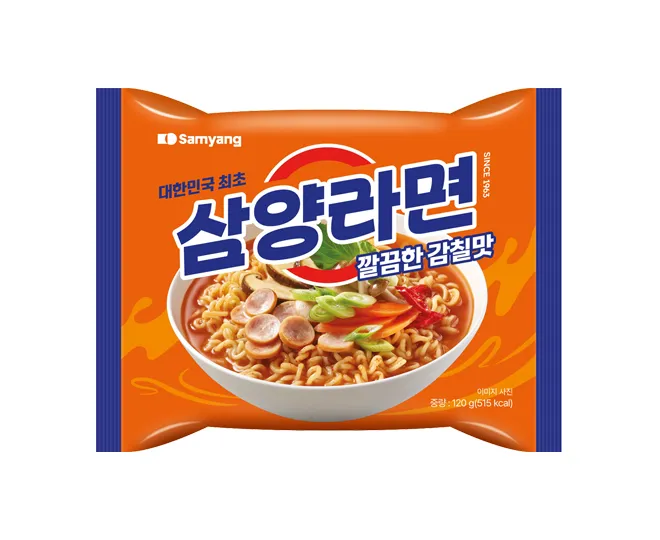
Samyang Ramen, Korea’s first instant ramen, was launched in 1963. It features a savory and slightly salty broth with a ham-flavored base. You can also catch a hint of sweetness in its taste.
8. Paldo Bibimmyeon (팔도 비빔면)
- Spice Level: Spicy (Medium for Koreans)
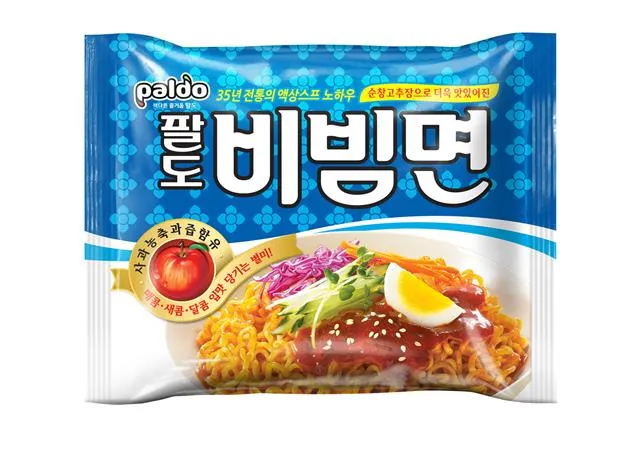
Paldo Bibimmyeon is a must-have cold ramen dish for Koreans in the summer. It features a spicy, sweet and tangy bibim sauce paired with thin, refreshing noodles – perfect for cooling down on hot days. The bibim sauce has become so popular that it’s now sold separately.
One of the best combinations is to enjoy it with Korean BBQ . It is a favorite combination in Korea. I guarantee you’ll love it!
- US: https://amzn.to/4iwzQAr, EU: https://amzn.to/4iqLzk8 (DE)
- Bibim Sauce: https://amzn.to/3DnBHbZ (NL), https://amzn.to/43pnaao (US)
7. Nongshim Yukgaejang Cup Ramen (농심 육개장 사발면)
- Spice Level: Spicy (Medium for Koreans)
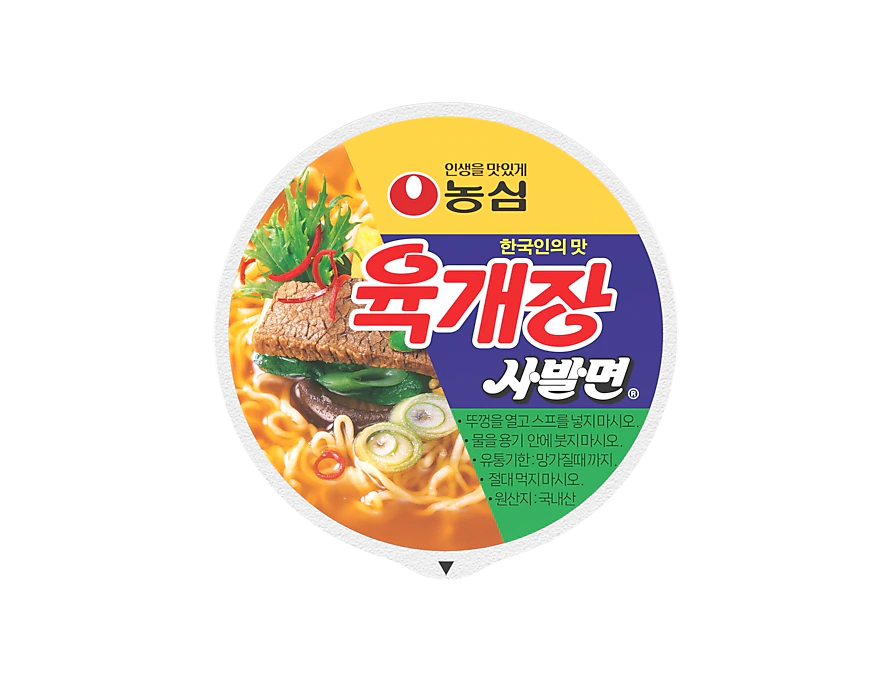
This ramen is inspired by yukgaejang, a traditional Korean soup made with beef and a spicy, hearty broth. It’s best enjoyed as a cup noodle. Many Koreans say the cup version tastes quite different from the packet version. It includes pieces of fish cake as part of the toppings.
6. Samyang Buldak Bokkeummyeon (삼양 불닭볶음면)
- Spice Level: Extreme Spicy (Spicy to Extreme Spicy for Koreans)
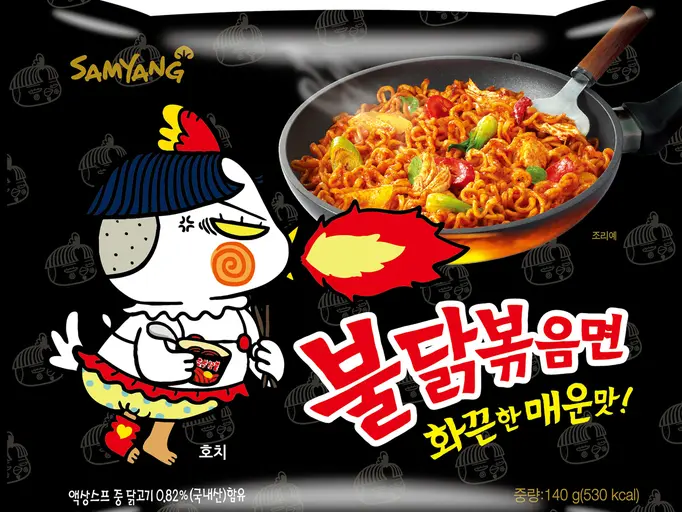
This is probably one of the most famous Korean ramens in the world. It is inspired by “Buldak”, a spicy Korean stir-fried chicken dish. Unlike traditional ramen, Buldak Bokkeummyeon is a stir-fried ramen without broth, known for its intense heat. In fact, it was once banned from export to Denmark due to its extreme heat!
For a milder option, try flavors like Carbonara Buldak or Cheese Buldak.
- Origianl Buldak : https://amzn.to/3DiEovB (US), https://amzn.to/3F3ixZp (NL), https://amzn.to/3D8wDs8 (DE)
- Carbonara Buldak: https://amzn.to/4i511Te (US), https://amzn.to/3F8gNOG (DE), https://amzn.to/3DlxDcl (NL)
- Cheese Buldak: https://amzn.to/4ktuBDs (US), https://amzn.to/43qFjVa (DE), https://amzn.to/3Fd4Ze3 (NL)
5. Nongshim Ansungtangmyun (농심 안성탕면)
- Spice Level: Mild
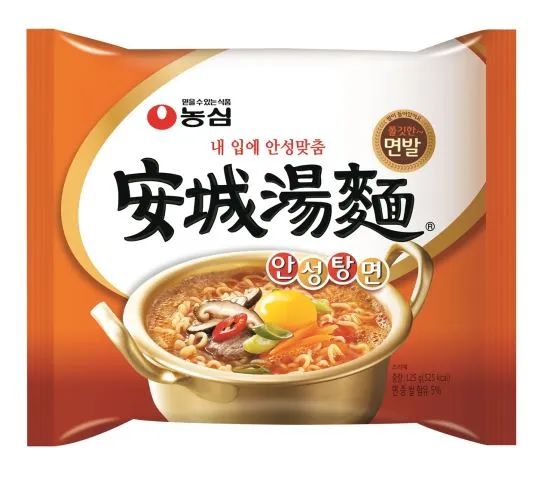
This ramen was created by Nongshim to compete with the popular Samyang ramen. Originally, it had a doenjang (Korean soybean paste) base with a beef broth flavor. However, it has since been revised to reduce the doenjang flavor and enhance the beef flavor, resulting in a rich beef bone (sagol) broth base.
- US: https://amzn.to/3DwihBJ, EU: https://amzn.to/3DaXeEX (DE)
4. Nongshim Neoguri (농심 너구리)
- Spice Level of Mild Neoguri: Mild
- Spice Level of Spicy Neoguri: Spicy (Medium for Koreans)
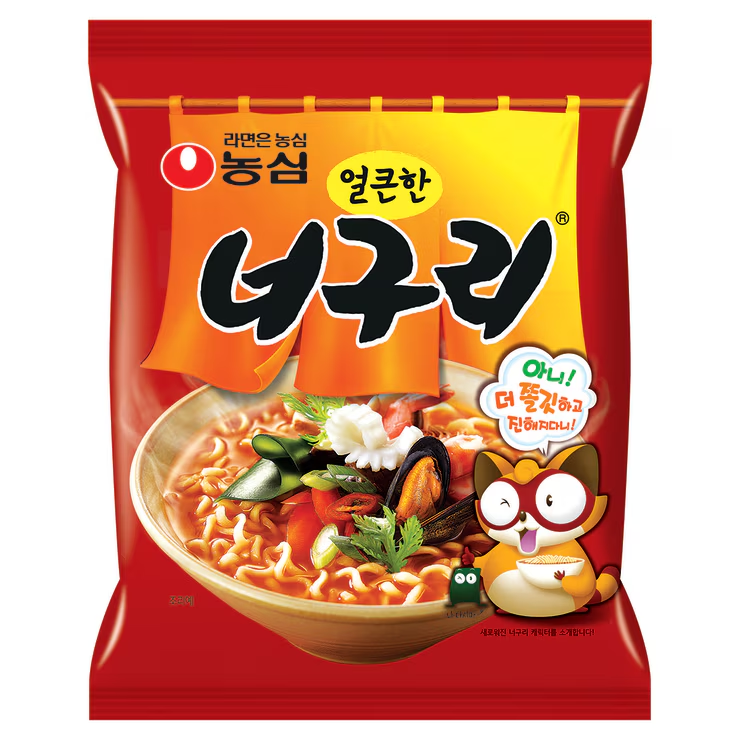
Neoguri is known for its thick, udon-like noodles and seafood-flavored broth. It includes pieces of kelp (dashima) to enhance the umami and a rich, savory seafood base. Whether you choose the mild or spicy version, it’s a flavorful and satisfying ramen with a unique taste.
- Mild Neoguri ramen: https://amzn.to/3DpwPmP (DE), https://amzn.to/3Fkl0Pc (NL)
- Spicy Neoguri ramen: https://amzn.to/3DpwLU7 (US), https://amzn.to/4hfXRe2 (DE), https://amzn.to/4ip8GLO (NL)
3. Nongshim Chapagetti (농심 짜파게티)
- Spice Level: Mild
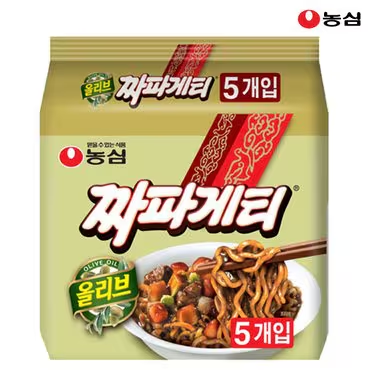
Chapagetti is Korea’s most popular instant jjajang (black bean sauce) ramen, inspired by the classic Korean-Chinese dish, jjajangmyeon. It’s a stir-fried ramen with a sweet and savory black bean flavor, not spicy at all. My foreign friends love Chapagetti’s delicious, slightly salty taste.
It gained even more fame when the movie Parasite popularized “Chapaguri” (a mix of Chapagetti and Neoguri) with steak.

- US: https://amzn.to/4iagUrz, EU: https://amzn.to/41w3qPH (DE), https://amzn.to/4i8P66O (NL)
2. Ottogi Jin Ramen (오뚜기 진라면)
- Spice Level of Mild Jin Ramen: Mild
- Spice Levelof Spicy Jin Ramen: Spicy
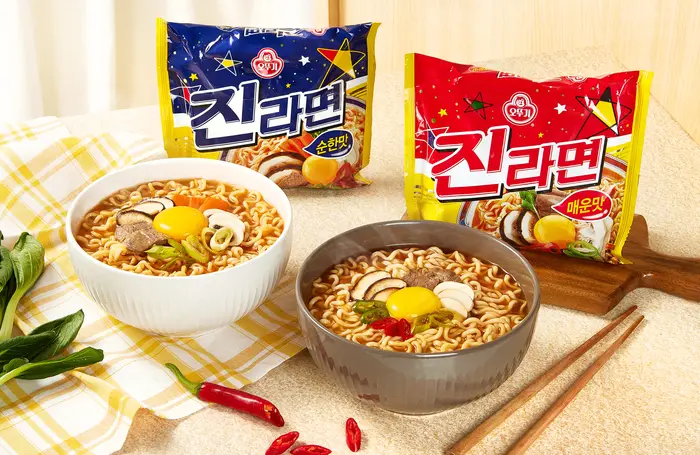
Jin Ramen is Ottogi’s signature ramen, available in mild and spicy versions. It features chewy noodles and a rich, savory broth with a harmonious blend of beef bone (sagol) flavor and umami. The soup includes green onions, shiitake mushrooms, and a variety of dried vegetables.
The mild version, with its nutty and slightly salty taste, is a favorite among kids, but it wasn’t as popular with Korean adults. The spicy version has always been a fan favorite in Korea. However, as Jin Ramen expanded internationally, more foreigners preferred the mild flavor, giving it newfound popularity.
- Spicy Jin Ramen: https://amzn.to/3DaZ1Kb (US), https://amzn.to/4buKBRw (DE), https://amzn.to/4kxwxL8 (NL)
- Mild Jin Ramen: https://amzn.to/4byqZMt (US), https://amzn.to/43psGtC (DE)
1. Nongshim Shin Ramen (농심 신라면)
- Spice Level: Spicy (Medium to Spicy for Koreans)
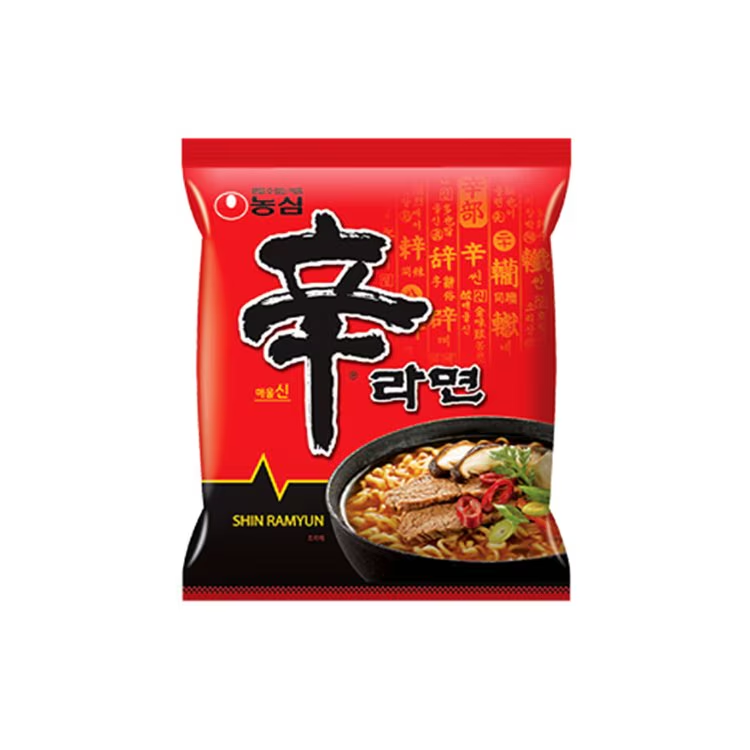
Shin Ramen is the ultimate representative of spicy Korean ramen. The name “Shin” (신) means “spicy” in Korean, and it truly lives up to its name. It has a signature umami flavor from soybean protein and beef powder, along with a rich mushroom broth from dried shiitake mushrooms. The mushrooms also add a delightful chewy texture.
Shin Ramen is a staple in many Korean households. If you open any pantry, there’s a good chance you’ll find a pack of Shin Ramen in it. I know my pantry is never without it!
What is Your Favorite Korean Ramen?
What’s your favorite ramen from this list? or is there a ramen you’d like to try? Let me know in the comments below! And if you end up trying any of the ramen I’ve recommended and love it, don’t forget to tag me on Instagram @blondekimchi_ I’d love to see it! Thanks so much!
